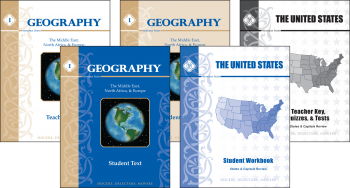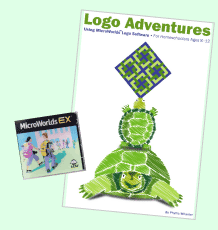Moving Beyond the Page is one of those companies that I had never heard of until I was blessed with the opportunity to review them. Now I am seeing them everywhere and wondering why I never did before (well, actually, that one is pretty easy to puzzle out - I have been seeing them constantly recommended on secular homeschooling lists, and I am usually all over Catholic homeschooling lists. Ironically, secular homeschooling lists are often the second place Catholic homeschoolers look for curriculum in order to avoid conflict with secondary doctrine issues that often arise with Protestant curriculum. However, I digress.). The point is, this curriculum is complete, engaging, and, most importantly, beloved by Therese (almost 12)!
In this Language Arts unit, Therese is learning all of the components of poetry (rhythm and meter, tone, allusions, figurative language, etc.) through the lens of modern British poets. Like all Moving Beyond the Page units, the curriculum is broken up into its component parts by days so that student knows exactly how much to do on a given day (I realize that such scheduling is not revolutionary to most people, but it kind of is to us!). For the online versions of Moving Beyond the Page units, subscribers are given access for 3 months. As each unit should take about 21 days, this should be plenty of time to complete the unit. If not, though, MBTH will extend your subscription if you make that request. Fortunately, your 3 months does not start until you activate the unit. If you're like me, then, and go nuts buying curriculum sometimes, your units will sit and wait for you until you are ready to use them!
Honestly, I found the day's assignments for both MBTP units a bit ambitious. Again, that's probably because we are much more "fly by the seat of our pants" homeschoolers. For that reason, Therese did not finish British Poetry yet (it doesn't help that this is one area in which I find it way too easy to take off on major tangents). She has learned so much so far, though. Each week, I have printed off the worksheets I anticipate her getting to. Then we read through the material together each day and discuss it. Actually, she would have finished if I had let her work alone, but I just can't begin talking about Elizabeth Barrett Browning and Robert Browning and then stop on a dime! In any case, I can talk about the Brownings, but I need help to teach the ins and outs of iambic pentameter, and Moving Beyond the Page has been my life saver!
Therese also got to complete the history unit: Ancient Asia. Like all good classical homeschoolers, we have "done" Ancient Greece and Rome to death, but Ancient Asia? Not so much. I knew that Therese only had a very passing familiarity with Chinese dynasties and Indian castes, but, given that she loves history more than anything, I thought this unit would be the perfect chance to fill in some of those blanks for her. It absolutely has! Unlike the Language Arts unit, Ancient Asia came to us as a spiral-bound unit study, which I infinitely prefer. Of course, I was not allowed to photocopy the worksheets or anything (whereas I could have made multiple copies of the online worksheets), but as Therese was the only one doing this unit, that wasn't an issue. If that is an issue for you, you can buy additional copies of the student pages on the website.
Ancient Asia cost $63.83, but in addition to the curriculum guide, it came with four additional books, all of which you can see here. Given the completeness of this curriculum, I think the price is fair. Again, although Therese finished this study, I think it can easily take longer than 20 or so days. There are many projects from which to choose. Therese skipped anything that seemed like art (Art? No!), but thrilled to answering any questions or writing whenever it was an option. She loved all the mapwork. Had my 8 year-old son been doing this study (which he wouldn't have been - it was beyond him), he would have been horrified by the writing, but delighted by the opportunities for creativity.
Now, although I have a degree in history, I left Therese alone with Ancient Asia. Perhaps because I didn't need to go online to print anything, I was able just to hand her the book and let her go to it. Maybe that's why she was able to finish! Every single day, she told me how much she loved it. She would bring me the day's work for me to check, tell me what she had learned, and ask if we could buy more units. With the exception of one other curriculum (the history program we do when we don't have a review product history going on), Therese is not that passionate about any other curriculum. I have been so pleasantly surprised!
Fortunately for Therese (and everyone else), Moving Beyond the Page has tons of choices in units! They have also done an amazing job coordinating all of them. For example, the company pairs its literature units with the relevant time in history, so if you're reading Number the Stars, you should also be doing the history unit on WWI/WWII (in fact, this is probably the unit set I am going to buy Therese next).
There is so much to this curriculum that it is hard to do it justice in a review. Fortunately, there is an active forum where you can ask questions and Keith, one of the owners (from College Station, TX - right down the road!), will answer you promptly. However, I will do my best to summarize the different ways you can buy Moving Beyond the Page:
- Full Year Packages - like other big-box curricula, you can buy the curriculum for your child's age and everything you need, from curriculum guides for Language Arts, Science, Social Studies, and Reading/Literature, to books, manipulatives, and supporting material will arrive at your door (this is the kind of mail day about which I fantasize). Add a math program and you're set. Really.
- Full Year Package Online - Includes everything above, but the curriculum guides are online. Save $100.
You can also order numerous permutations of the above. You can order curriculum guides only, second set student consumables, single subjects, and so much more. Clicking on either of the above links will walk you through all choices for the 11-13 year-old set. Alternatively, you can just buy single unit studies if you want to supplement an existing curriculum (or engage in the ever-exciting delight-directed learning!). As much as I drool over the full year package, it will never be a financial option for me. However, I can play with single studies and find something fun for each of my kids! Because I infinitely prefer having the hard copy of the curriculum guide, I love having the option of purchasing additional student pages.
Still not sure about Moving Beyond the Page? There is a lot to take in. First, read the Crew reviews by clicking on the banner below. Many different studies were reviewed. Second, check out the many samples MBTP has on its site. Fair warning: you're going to love what you see!












.jpg)
.jpg)


